Post by TasunkaWitko on Nov 26, 2013 23:36:58 GMT -5
Russian Cabbage Soup
Щи (Shchi)
Wikipedia describes shchi as "a Russian soup with cabbage as the primary ingredient...." The article goes on to provide some historical background:
Based on the information above, it is quite obvious that this ancient, fundamental soup is very open to interpretation, improvisation and use of ingredients or staples on hand. This pictorial represents my interpretation of the recipe provided by my friend Brook, and I'd like to thank him for opening such a delicious door. Here is the recipe, with a link to the related discussion that we had on shchi:
Reading this recipe, you might find yourself puzzled by a few of the ingredients: the brown sugar, the raisins and the vinegar. Trust me, they do belong there, and they do add some great highlights to the soup! They bring a sort of sweet/sour element that is very pleasant, and in particular they set off the meat, tomatoes and the cabbage very well, in my opinion.
Notice also, that Brook's recipe specifies beef brisket (or any similar cut of beef); both times that I have made this, I happened to have no cuts of beef in the house - only burger - so I used pork in the form of kiełbasa-type sausages with great results.
Anyway, here's a shot of everything I used:

Much of the produce that you see here came either from my parents' garden (the tomatoes) or was purchased from a local Hutterite colony (onions, garlic and carrots); fresh and delicious, this produce contributed in wonderful ways toward the brilliant flavour of the soup. I really wish that I would have had some fresh Hutterite-grown cabbage, because the ones I saw at the farmers' market were big, beautiful and would have been perfect for this.
You might be asking yourself, what is that in the red bowl?
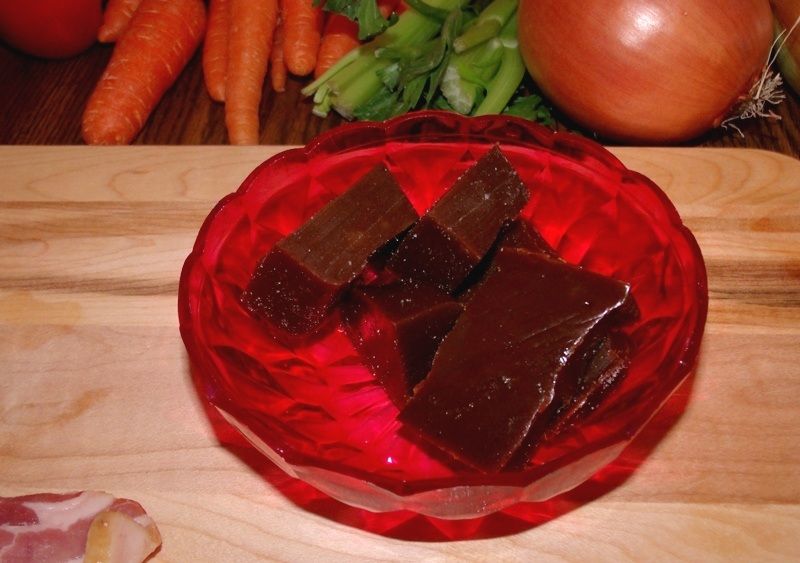
Well, those are a few cubes of glace de viande, a wonderful way to use meaty bones, carrots, onions and celery to produce a gigantic flavour punch that will send anything you make into orbit. You can learn more about glace de viande and how to make it here:
foodsoftheworld.activeboards.net/glace-de-viande-your-secret-weapon-for-flavour_topic2482.html
With that, I began my prep work, so that everything would be in place while I was making the soup. First, I diced my bacon:
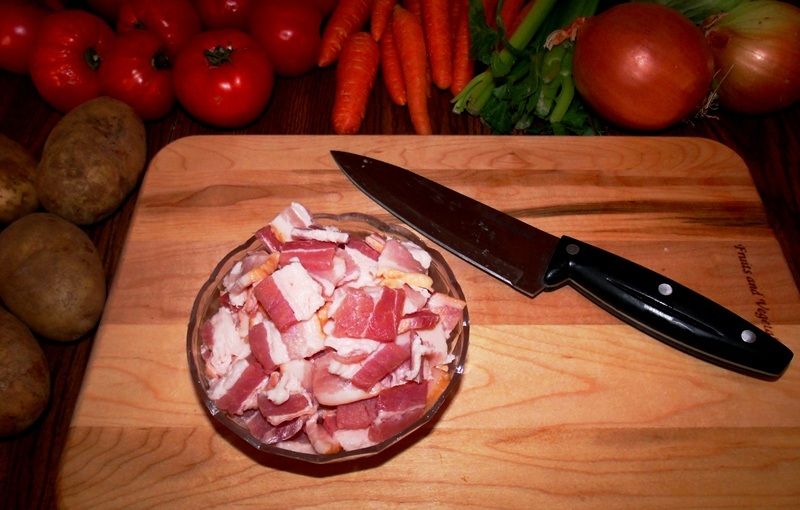
Yes, I used some extra bacon - no, I do not feel one bit guilty!
After that, I cut the kiełbasa into quartered slices as shown above.

I probably used a little extra kiełbasa too, but it's all good!
Now, the vegetables - first the onions:
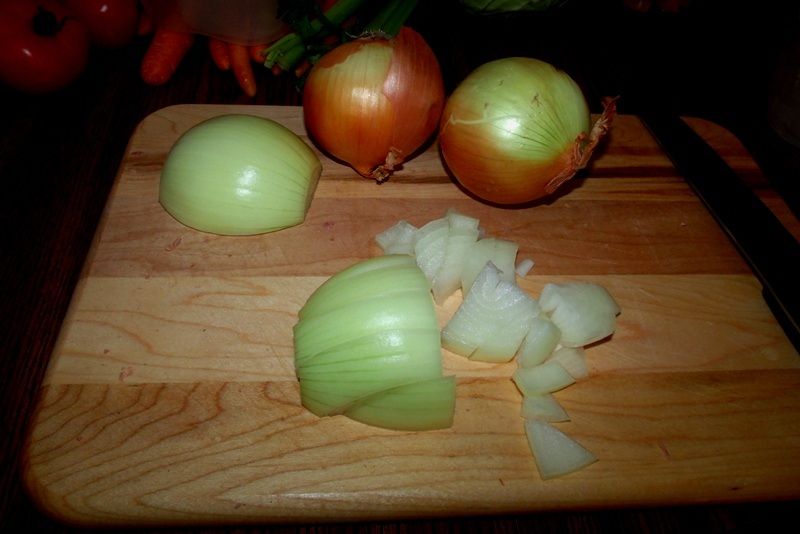
Then the carrots:
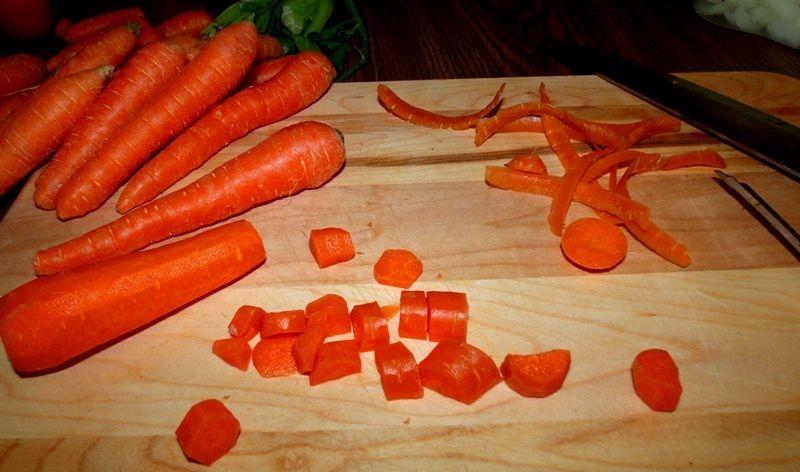
I tried the keep the carrots relatively uniform in size and thickness - but not too perfect:
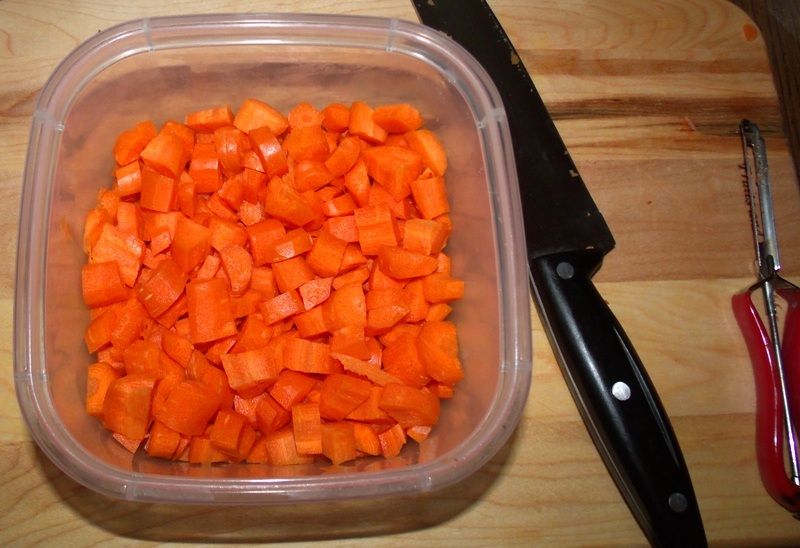
After the carrots, I diced the celery finely - also the wonderful, fragrant garlic:
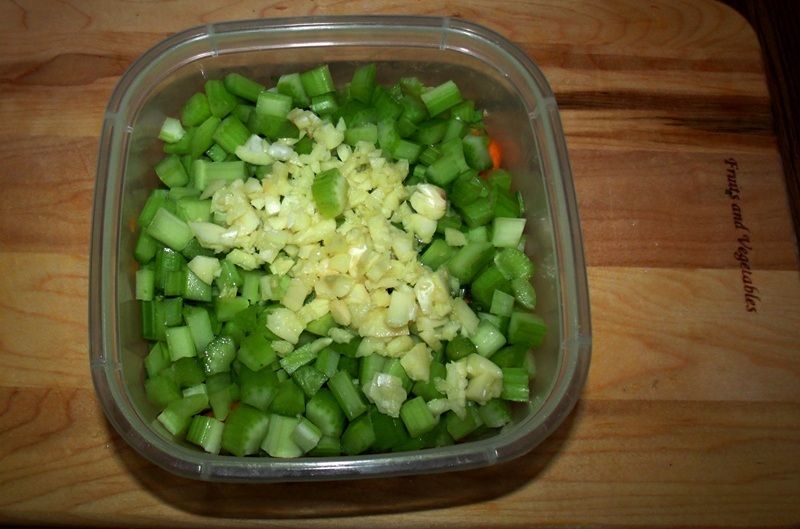
Next, the cabbage, which I quartered, cored and then chopped:
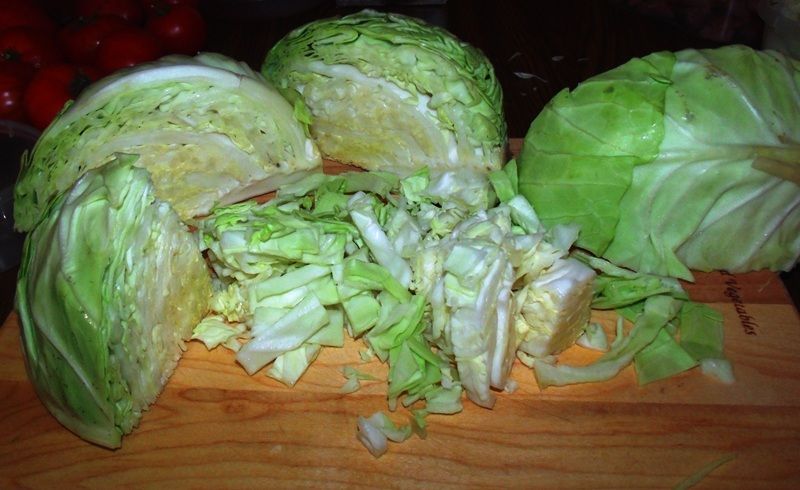
Those of you who have worked with cabbage know that when you chop it up, even a small head of cabbage seems to grow into a gigantic pile. This is one of my favourite things about it, and one of the primary reasons that this healthy leaf vegetable is such a widely-used food staple in the world; it packs a lot of nutrition into a small, portable package, and tastes good with so many things - especially shchi!
You cannot tell by looking, but this is actually quite a large TupperWare-type bowl, filled to the brim with chopped cabbage:
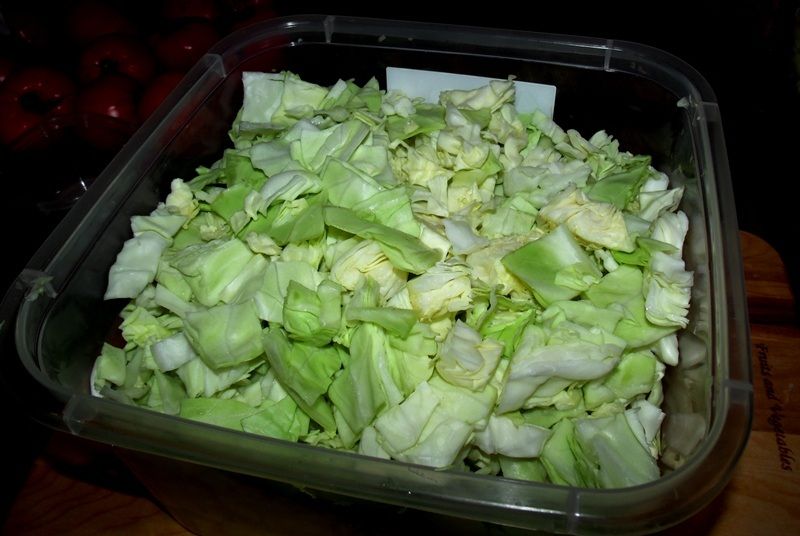
After the cabbage, I diced the potatoes:
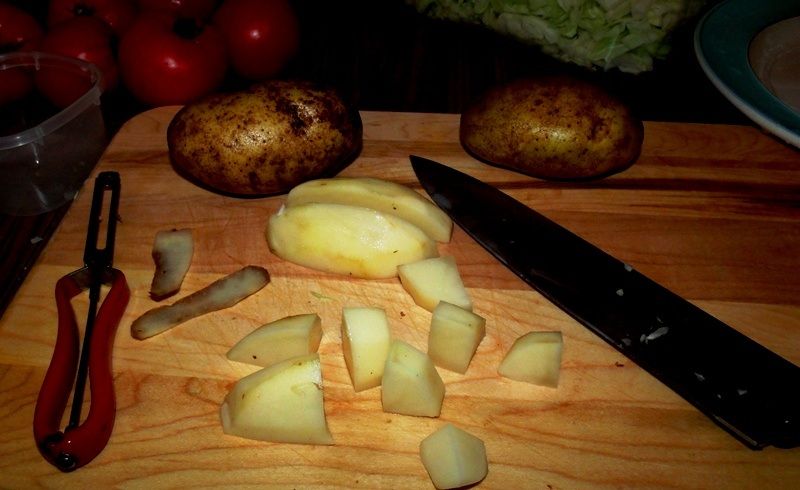
I then chopped the tomatoes, which were grown by my dad with help from my youngest son:
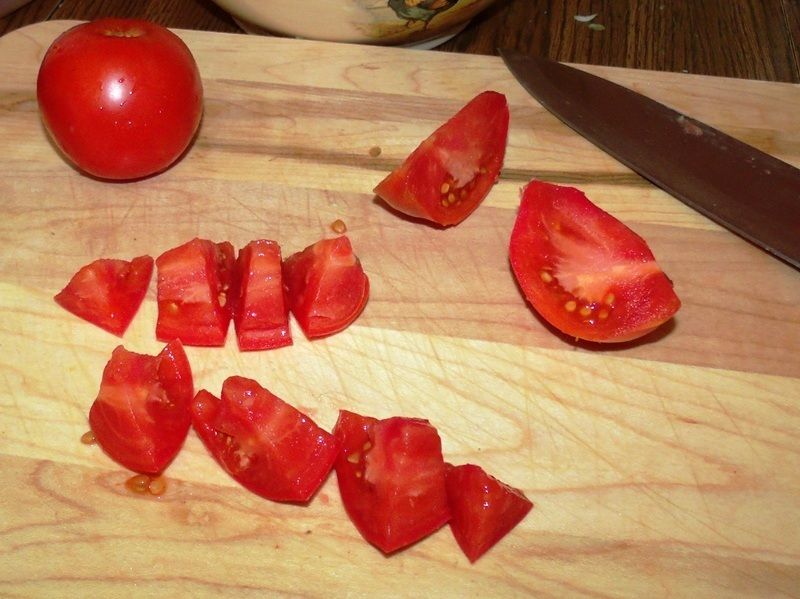
Don't they look nice? They tasted delicious, as well! Full of tomato-ey flavour, juicy and bright red, with a wholesomeness that will never come from a modern supermarket.
Finally, I measured the apple cider vinegar, brown sugar and raisins:

Not really a necessary step, but oh well - there it is.
With that, I began the actual preparation of the shchi by slowly cooking and rendering down my bacon:
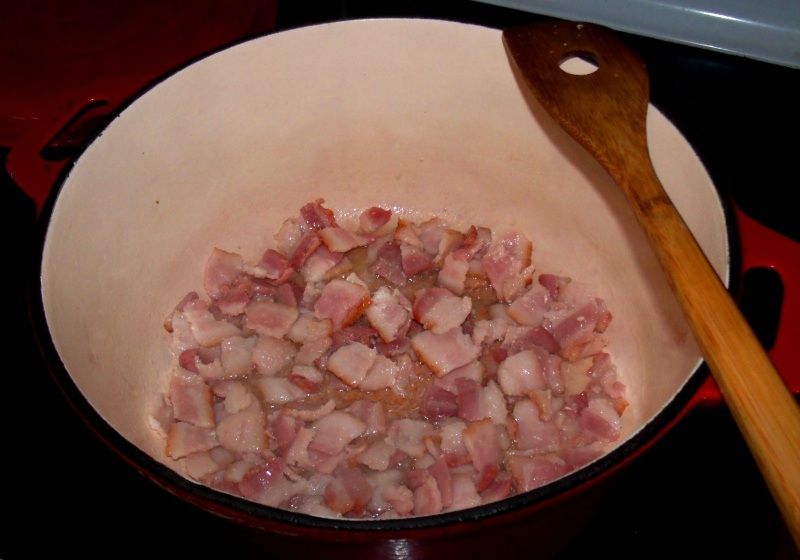
When the bacon got to about this point:
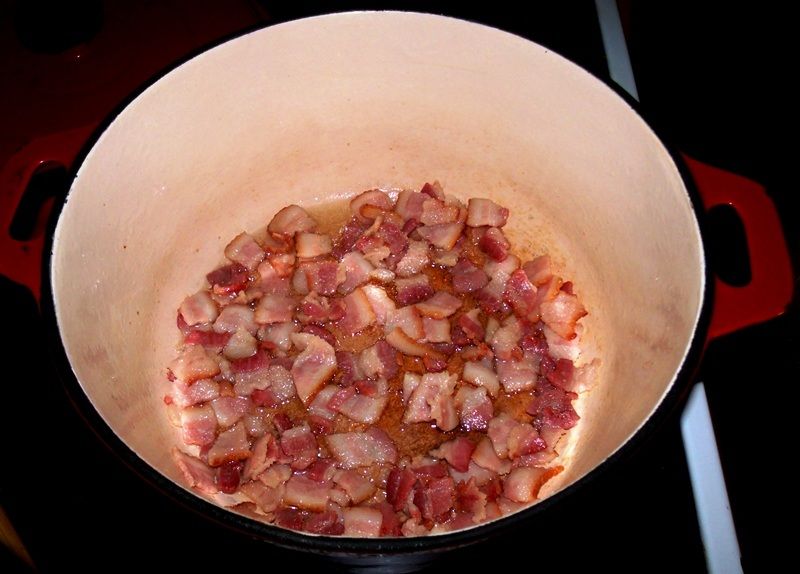
I added the diced kiełbasa:
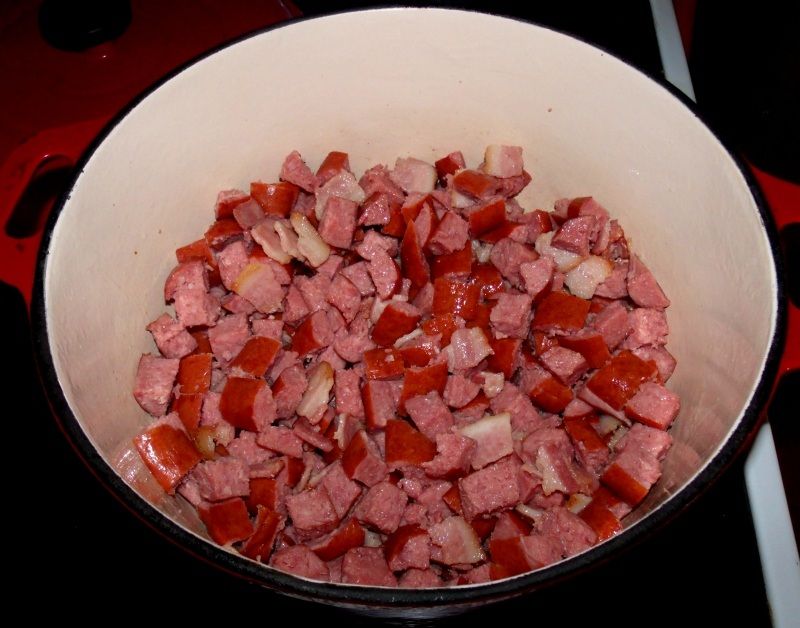
I then continued to cook the pork down until the kiełbasa looked about like this:
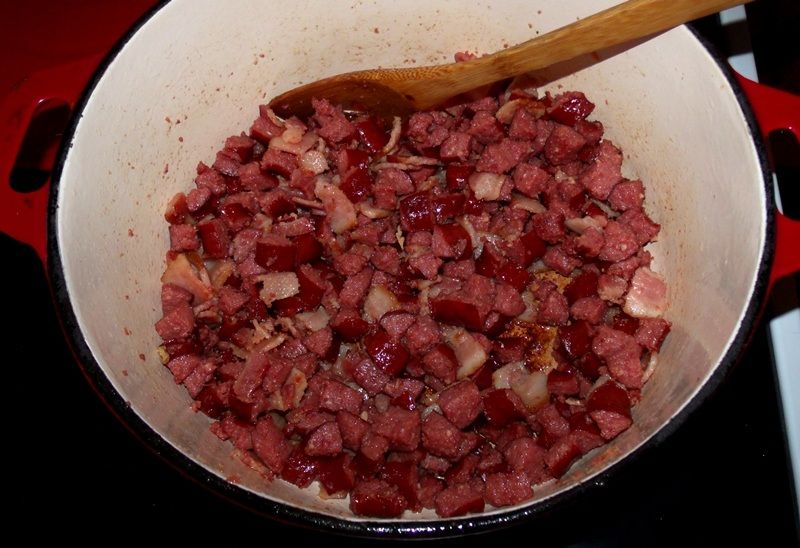
These meats rendered out an obscene amount of pork fat, so when the meats were at the stage I wanted them to be at, I poured off all but a couple of tablespoons, and added my onions:
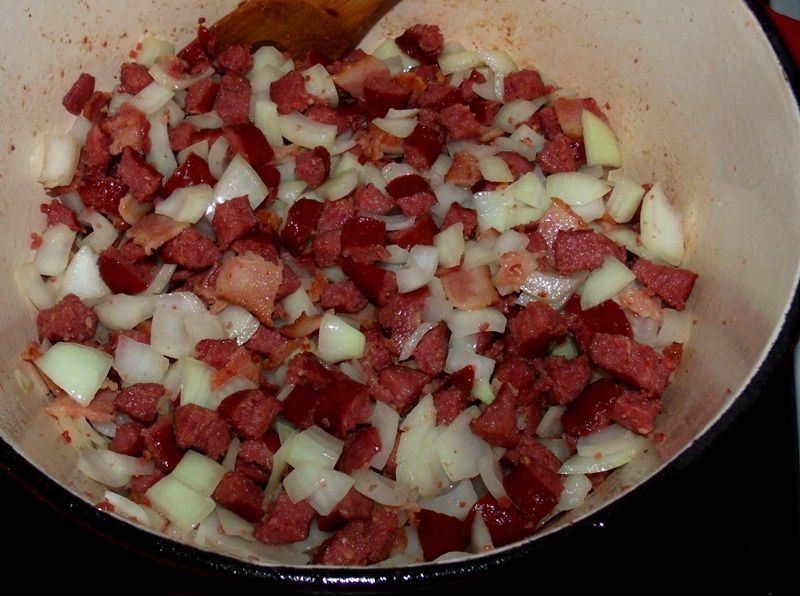
Onions and pork fat are meant to be together - there is absolutely no denying it, so it is useless to try. I slowly cooked the onions, stirring occasionally, as they lifted the fond from the bottom of the pot and went from translucent to golden:

I then added the carrots, celery and garlic:
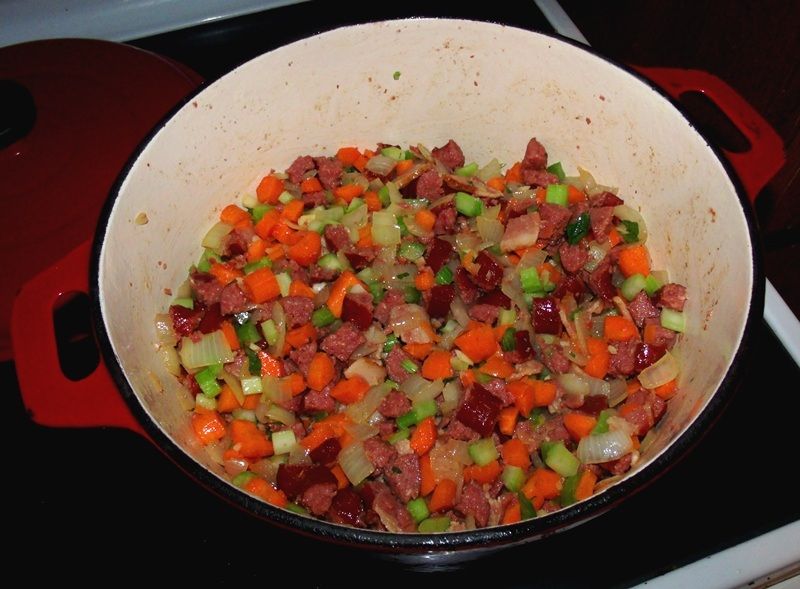
Followed by the potatoes:
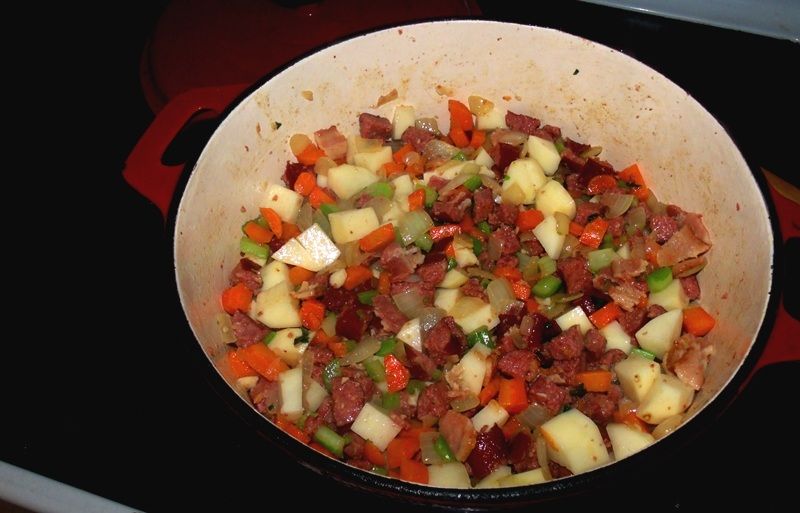
I allowed these ingredients to cook, covered, stirring occasionally for perhaps 10 or 15 minutes; I then added all of the tomatoes (and their accompanying juice), the cubes of glace de viande, about half the water called for in the recipe, since I was expecting a lot to be released by the fresh tomatoes. I used water rather than salty broth, and it worked very well with the flavour-packed glace de viande.
Then, I added the cabbage:
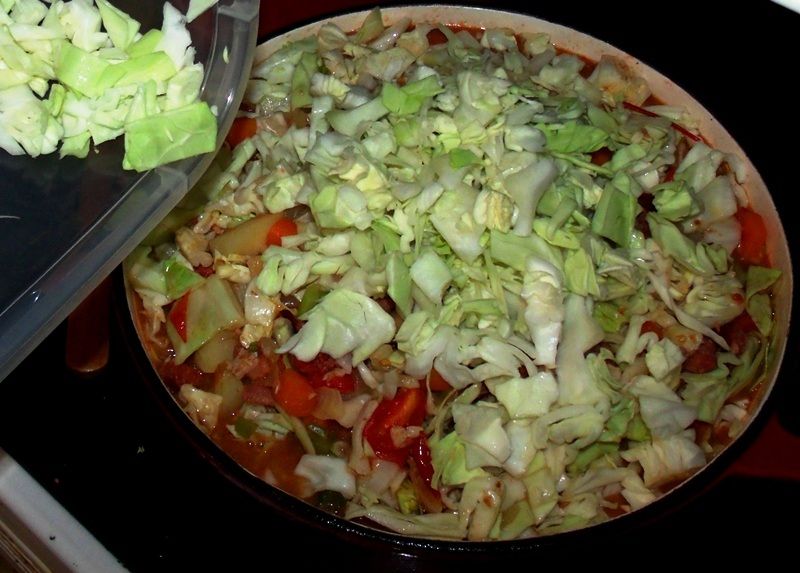
All of the cabbage....
Even though my Tramontina enameled cast-iron Dutch oven holds 6.5 quarts, I had my doubts as to whether this would all fit in the pot; luckily, cabbage cooks down dramatically, so after adding half of it and then stirring and allowing it to wilt a bit - I was able to add the other half.
Coincidentally, this cookware is currently being offered for an incredibly-good price at WalMart.com:
www.walmart.com/ip/Tramontina-6.5-Qt-Enameled-Round-Cast-Iron-Dutch-Oven/29114481
I've been extremely satisfied with mine; no, it's not Le Creuset - but then again, I didn't need a second mortgage to buy it, and it has so far performed well beyond my expectations. It also received top ratings from Cook's Illustrated's test kitchen, and it's pretty hard to argue with that. One could do a lot worse!
By the time all the cabbage was in there, it looked like the Dutch oven was going to over-flow:
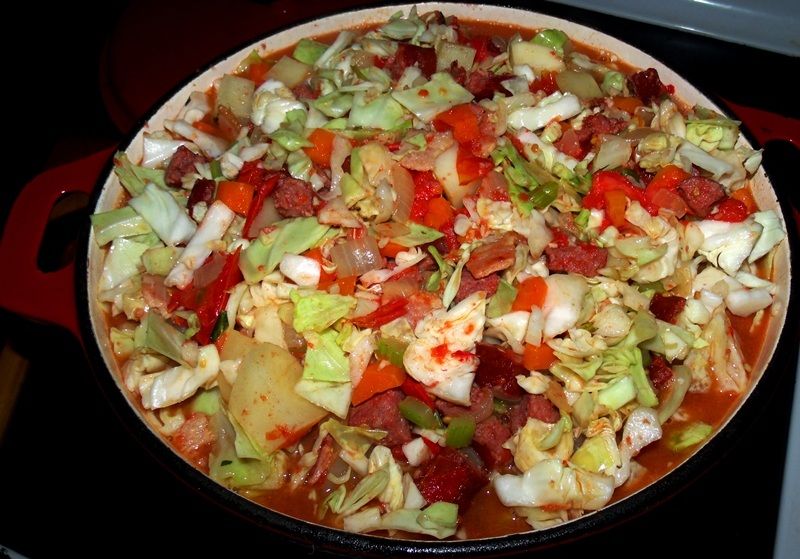
No worries, though - I simply put the heavy lid down, turned the heat to a simmer and let the soup cook for a while.
After perhaps an hour-and-a-half of slow simmering, the vegetables were starting to get tender and the shchi was well on its way to being done. I lifted the lid to see how things were going, and also to add the raisins, brown sugar and the vinegar:
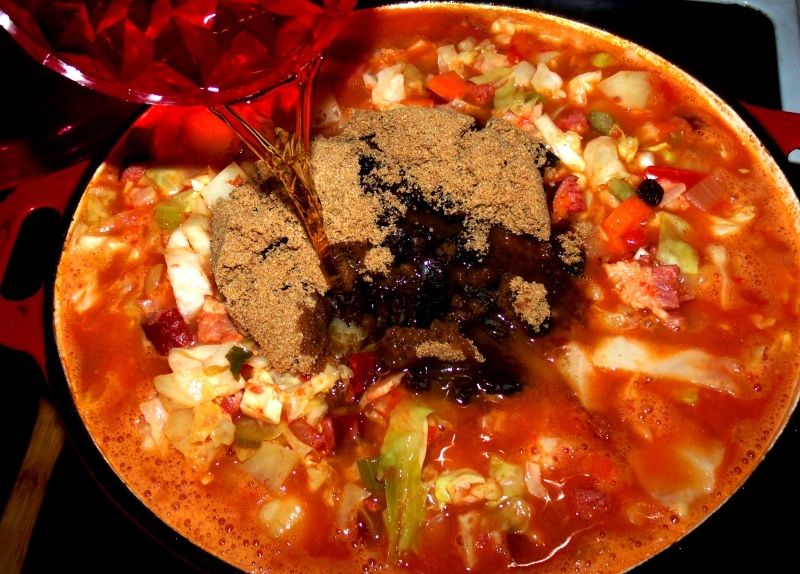
I cannot stress enough how much these unique components add to the final soup! The amounts that you use can be tweaked to your preference, and to the other ingredients, allowing you to produce a very well-balanced dish with huge flavour potential.
As you can see, the moisture released by the tomatoes, cabbage and other vegetables helped to fill the pot to the brim; luckily, that's all the farther it got, and at this point I began simmering the soup, uncovered, in order to allow the vegetables to get fully done while the flavours proceeded to develop.
After an additional half an hour or so of simmering and occasional stirring, I judged the soup to be ready:
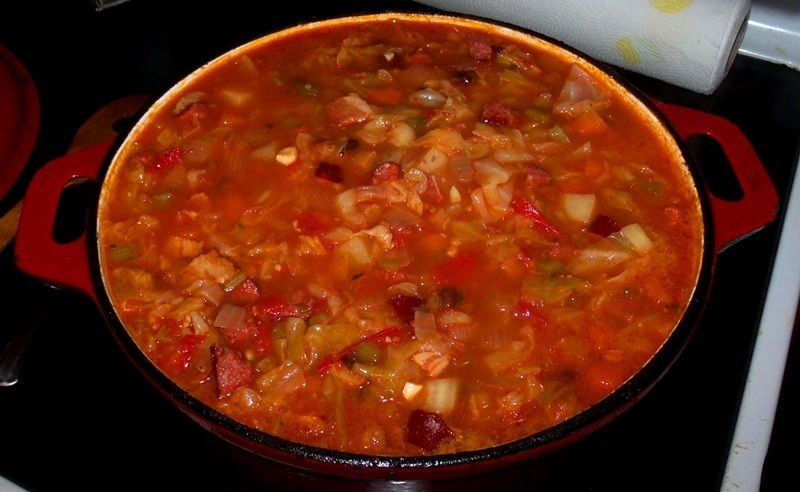
Looking pretty good, I think! It can simmer all day, and only get better; that's the beauty of this stuff! It smelled absolutely delicious, full of fresh, garden-y promise with a smoky undertone coming from the pork. It was a perfect, warm, inviting thing to have on a chilly autumn day.
I carefully carried the pot of shchi to the table:

And began to dish it up, much to the relief of the starving group of refugees that were huddled around me:
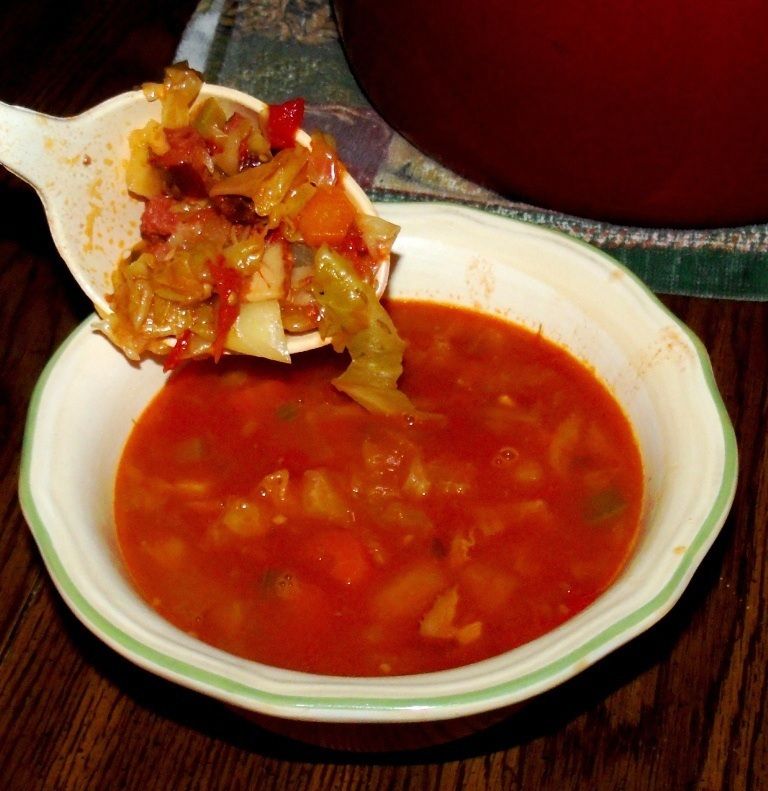
The shchi was served simply, with only fresh, buttered Hutterite-baked bread as a garnish:
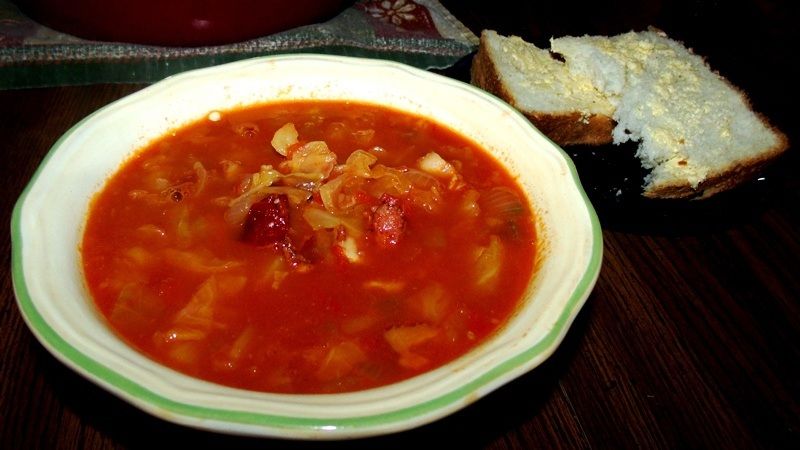
We then dove right into one of the best home-cooked meals that a person can enjoy.
Keep in mind that this preparation is only my interpretation of Brook's recipe; as already noted, I used pork rather than his beef - this certainly gives the shchi a more Ukrainian touch. Also, I am pretty sure that due to all of the fresh tomatoes I used, mine is probably a lot "redder" than Brook's would be, and probably making it more of a summer or late-summer soup, rather than a winter soup. Having said that, this is all really of no consequence; as is the case with so much humble, peasant cooking from the land, your final results are going to be determined by components and ingredients, which in turn are determined by availability, season, personal preference and social or financial state at the time. Slight variations are also going to be found from region-to-region, province-to-province, village-to-village, and cottage-to-cottage. Only the fundamentals are going to remain constant, and the bottom line is that each of our dishes is shchi - and each of our interpretations is delicious.
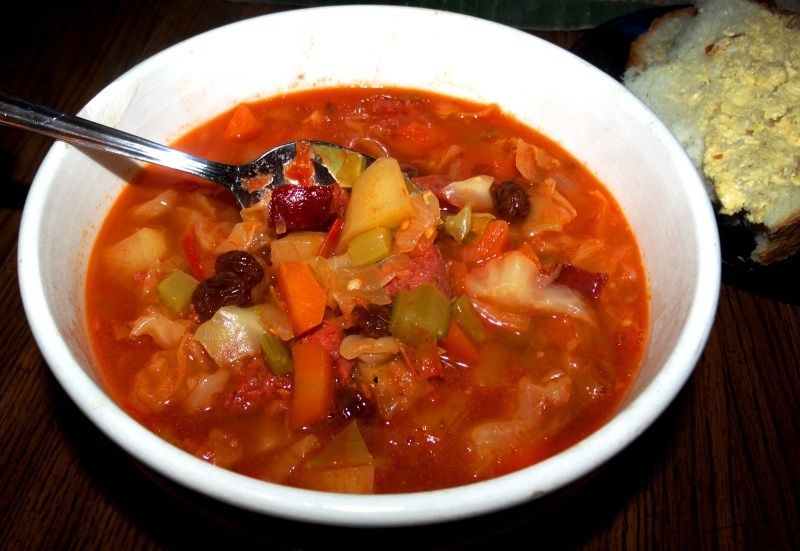
The vegetables were cooked perfectly; tender and contributing to the whole whilst retaining their own flavour. The soup was savory, brimming with a bright goodness that comes from a well-balanced, home-cooked meal. The addition of the raisins was a true treat, each bursting with a tangy surprise for the palate. The brown sugar and vinegar - ingredients whose amount can be tweaked for balance - drew everything into focus, bringing out flavours from all components that would surely not have been noticed otherwise.
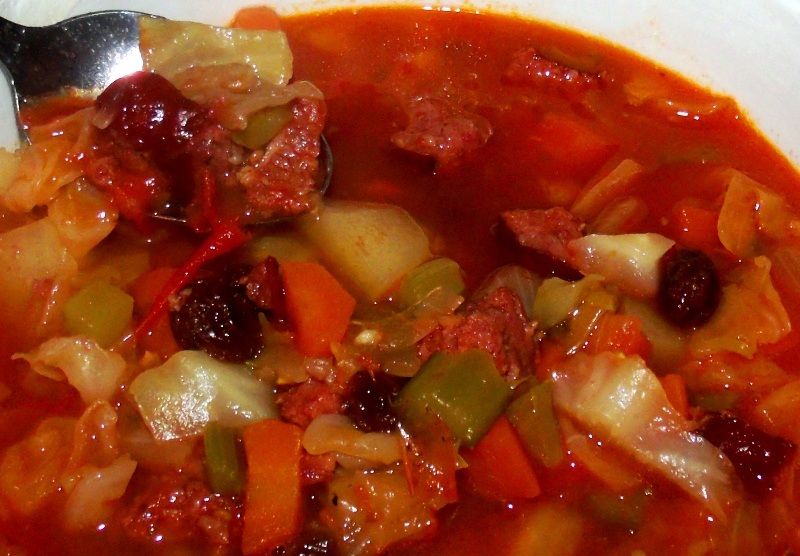
Thank you for looking, and I hope that seeing this will inspire some of you to give a try for one of your winter meals; then again, it can be just as good as a summer dish, as well - so why not put it on your home's rotation? As always, if anyone has any questions or comments, please post them here.
Приятного аппетита!
Щи (Shchi)
Wikipedia describes shchi as "a Russian soup with cabbage as the primary ingredient...." The article goes on to provide some historical background:
Shchi is a traditional soup of Russia where it has been known as far back as the 9th century, soon after cabbage was introduced from Byzantium. Its popularity in Russia originates from several factors. Shchi is relatively easy to prepare; it can be cooked with or without various types of meat that makes it compatible with different religions; and it can be frozen and carried as a solid on a trip to be cut up when needed. Finally, it was noticed that most people do not get sick of shchi and can eat it daily. This property is referenced in the Russian saying: "Pодной отец надоест, а щи – никогда!" (Rodnoi otets nadoyest, a shchi—nikogda! "One may become fed up with one's own father, but never with shchi!"). As a result, by the 10th century shchi became a staple food of Russia, and another popular saying sprang from this fact: "Щи да каша — пища наша." (Shchi da kasha — pishcha nasha. "Shchi and kasha are our staples"). The major components of shchi were originally cabbage, meat (beef, pork, lamb, or poultry), mushrooms, flour, and spices (based on onion and garlic). Cabbage and meat were cooked separately and smetana [sour cream] was added as a garnish before serving. Shchi is traditionally eaten with rye bread.
The ingredients of shchi gradually changed. Flour, which was added in early times to increase the soup's caloric value, was excluded for the sake of finer taste. The spice mixture was enriched with black pepper and bay leaf, which were imported to Russia around the 15th century, also from Byzantium. Meat was sometimes substituted by fish, and carrot and parsley could be added to the vegetables. Beef was the most popular meat for shchi, while pork was more common in Ukraine. The water to cabbage ratio varied and whereas early shchi were often so viscous that a spoon could stand in it, more diluted preparation was adopted later.
Nowadays soup ingredients include: meat (mainly pork), cabbage, potato, tomato, carrot, onion (some people like to make the *obzharka*, обжарка, roasting carrot with onion before adding it to the soup) and spices (pepper, salt and parsley)....
The two-letter word щи contains the letter щ, which is absent in most non-Cyrillic alphabets and is transcribed into them with several letters. In German, щи becomes eight letters, schtschi.
en.wikipedia.org/wiki/shchi
The ingredients of shchi gradually changed. Flour, which was added in early times to increase the soup's caloric value, was excluded for the sake of finer taste. The spice mixture was enriched with black pepper and bay leaf, which were imported to Russia around the 15th century, also from Byzantium. Meat was sometimes substituted by fish, and carrot and parsley could be added to the vegetables. Beef was the most popular meat for shchi, while pork was more common in Ukraine. The water to cabbage ratio varied and whereas early shchi were often so viscous that a spoon could stand in it, more diluted preparation was adopted later.
Nowadays soup ingredients include: meat (mainly pork), cabbage, potato, tomato, carrot, onion (some people like to make the *obzharka*, обжарка, roasting carrot with onion before adding it to the soup) and spices (pepper, salt and parsley)....
The two-letter word щи contains the letter щ, which is absent in most non-Cyrillic alphabets and is transcribed into them with several letters. In German, щи becomes eight letters, schtschi.
en.wikipedia.org/wiki/shchi
Based on the information above, it is quite obvious that this ancient, fundamental soup is very open to interpretation, improvisation and use of ingredients or staples on hand. This pictorial represents my interpretation of the recipe provided by my friend Brook, and I'd like to thank him for opening such a delicious door. Here is the recipe, with a link to the related discussion that we had on shchi:
Russian Cabbage Soup
2 lb beef brisket, in half-inch cubes
1/4 cup diced bacon
2 cups onion, sliced
1 cup carrots, sliced
1 cup celery, sliced
6-8 cups beef and/or chicken stock
1 can tomatoes
2 medium potatoes, in ½ cubes
1 head cabbage, shredded
1/2 cup raisins
3 tbsp brown sugar
2 tbsp cider vinegar
Salt and pepper to taste
Sauté bacon until slightly browned. Add the onion, carrots, and celery. Sauté until onion turns translucent. Add the brisket and brown on all sides. Add the stock and tomatoes.
Bring to boil, reduce heat, and simmer until meat is just tender (about 45 minutes). Add potatoes and cook until tender (about 30 minutes more).
Add the cabbage, raisins, sugar and vinegar. Cook until cabbage is tender. Season with salt and pepper. Adjust flavor with additional sugar or vinegar as needed.
foodsoftheworld.activeboards.net/russian-cabbage-soup_topic2708.html
2 lb beef brisket, in half-inch cubes
1/4 cup diced bacon
2 cups onion, sliced
1 cup carrots, sliced
1 cup celery, sliced
6-8 cups beef and/or chicken stock
1 can tomatoes
2 medium potatoes, in ½ cubes
1 head cabbage, shredded
1/2 cup raisins
3 tbsp brown sugar
2 tbsp cider vinegar
Salt and pepper to taste
Sauté bacon until slightly browned. Add the onion, carrots, and celery. Sauté until onion turns translucent. Add the brisket and brown on all sides. Add the stock and tomatoes.
Bring to boil, reduce heat, and simmer until meat is just tender (about 45 minutes). Add potatoes and cook until tender (about 30 minutes more).
Add the cabbage, raisins, sugar and vinegar. Cook until cabbage is tender. Season with salt and pepper. Adjust flavor with additional sugar or vinegar as needed.
foodsoftheworld.activeboards.net/russian-cabbage-soup_topic2708.html
Reading this recipe, you might find yourself puzzled by a few of the ingredients: the brown sugar, the raisins and the vinegar. Trust me, they do belong there, and they do add some great highlights to the soup! They bring a sort of sweet/sour element that is very pleasant, and in particular they set off the meat, tomatoes and the cabbage very well, in my opinion.
Notice also, that Brook's recipe specifies beef brisket (or any similar cut of beef); both times that I have made this, I happened to have no cuts of beef in the house - only burger - so I used pork in the form of kiełbasa-type sausages with great results.
Anyway, here's a shot of everything I used:

Much of the produce that you see here came either from my parents' garden (the tomatoes) or was purchased from a local Hutterite colony (onions, garlic and carrots); fresh and delicious, this produce contributed in wonderful ways toward the brilliant flavour of the soup. I really wish that I would have had some fresh Hutterite-grown cabbage, because the ones I saw at the farmers' market were big, beautiful and would have been perfect for this.
You might be asking yourself, what is that in the red bowl?

Well, those are a few cubes of glace de viande, a wonderful way to use meaty bones, carrots, onions and celery to produce a gigantic flavour punch that will send anything you make into orbit. You can learn more about glace de viande and how to make it here:
foodsoftheworld.activeboards.net/glace-de-viande-your-secret-weapon-for-flavour_topic2482.html
With that, I began my prep work, so that everything would be in place while I was making the soup. First, I diced my bacon:

Yes, I used some extra bacon - no, I do not feel one bit guilty!
After that, I cut the kiełbasa into quartered slices as shown above.

I probably used a little extra kiełbasa too, but it's all good!
Now, the vegetables - first the onions:

Then the carrots:

I tried the keep the carrots relatively uniform in size and thickness - but not too perfect:

After the carrots, I diced the celery finely - also the wonderful, fragrant garlic:

Next, the cabbage, which I quartered, cored and then chopped:

Those of you who have worked with cabbage know that when you chop it up, even a small head of cabbage seems to grow into a gigantic pile. This is one of my favourite things about it, and one of the primary reasons that this healthy leaf vegetable is such a widely-used food staple in the world; it packs a lot of nutrition into a small, portable package, and tastes good with so many things - especially shchi!
You cannot tell by looking, but this is actually quite a large TupperWare-type bowl, filled to the brim with chopped cabbage:

After the cabbage, I diced the potatoes:

I then chopped the tomatoes, which were grown by my dad with help from my youngest son:

Don't they look nice? They tasted delicious, as well! Full of tomato-ey flavour, juicy and bright red, with a wholesomeness that will never come from a modern supermarket.
Finally, I measured the apple cider vinegar, brown sugar and raisins:

Not really a necessary step, but oh well - there it is.
With that, I began the actual preparation of the shchi by slowly cooking and rendering down my bacon:

When the bacon got to about this point:

I added the diced kiełbasa:

I then continued to cook the pork down until the kiełbasa looked about like this:

These meats rendered out an obscene amount of pork fat, so when the meats were at the stage I wanted them to be at, I poured off all but a couple of tablespoons, and added my onions:

Onions and pork fat are meant to be together - there is absolutely no denying it, so it is useless to try. I slowly cooked the onions, stirring occasionally, as they lifted the fond from the bottom of the pot and went from translucent to golden:

I then added the carrots, celery and garlic:

Followed by the potatoes:

I allowed these ingredients to cook, covered, stirring occasionally for perhaps 10 or 15 minutes; I then added all of the tomatoes (and their accompanying juice), the cubes of glace de viande, about half the water called for in the recipe, since I was expecting a lot to be released by the fresh tomatoes. I used water rather than salty broth, and it worked very well with the flavour-packed glace de viande.
Then, I added the cabbage:

All of the cabbage....
Even though my Tramontina enameled cast-iron Dutch oven holds 6.5 quarts, I had my doubts as to whether this would all fit in the pot; luckily, cabbage cooks down dramatically, so after adding half of it and then stirring and allowing it to wilt a bit - I was able to add the other half.
Coincidentally, this cookware is currently being offered for an incredibly-good price at WalMart.com:
www.walmart.com/ip/Tramontina-6.5-Qt-Enameled-Round-Cast-Iron-Dutch-Oven/29114481
I've been extremely satisfied with mine; no, it's not Le Creuset - but then again, I didn't need a second mortgage to buy it, and it has so far performed well beyond my expectations. It also received top ratings from Cook's Illustrated's test kitchen, and it's pretty hard to argue with that. One could do a lot worse!
By the time all the cabbage was in there, it looked like the Dutch oven was going to over-flow:

No worries, though - I simply put the heavy lid down, turned the heat to a simmer and let the soup cook for a while.
After perhaps an hour-and-a-half of slow simmering, the vegetables were starting to get tender and the shchi was well on its way to being done. I lifted the lid to see how things were going, and also to add the raisins, brown sugar and the vinegar:

I cannot stress enough how much these unique components add to the final soup! The amounts that you use can be tweaked to your preference, and to the other ingredients, allowing you to produce a very well-balanced dish with huge flavour potential.
As you can see, the moisture released by the tomatoes, cabbage and other vegetables helped to fill the pot to the brim; luckily, that's all the farther it got, and at this point I began simmering the soup, uncovered, in order to allow the vegetables to get fully done while the flavours proceeded to develop.
After an additional half an hour or so of simmering and occasional stirring, I judged the soup to be ready:

Looking pretty good, I think! It can simmer all day, and only get better; that's the beauty of this stuff! It smelled absolutely delicious, full of fresh, garden-y promise with a smoky undertone coming from the pork. It was a perfect, warm, inviting thing to have on a chilly autumn day.
I carefully carried the pot of shchi to the table:

And began to dish it up, much to the relief of the starving group of refugees that were huddled around me:

The shchi was served simply, with only fresh, buttered Hutterite-baked bread as a garnish:

We then dove right into one of the best home-cooked meals that a person can enjoy.
Keep in mind that this preparation is only my interpretation of Brook's recipe; as already noted, I used pork rather than his beef - this certainly gives the shchi a more Ukrainian touch. Also, I am pretty sure that due to all of the fresh tomatoes I used, mine is probably a lot "redder" than Brook's would be, and probably making it more of a summer or late-summer soup, rather than a winter soup. Having said that, this is all really of no consequence; as is the case with so much humble, peasant cooking from the land, your final results are going to be determined by components and ingredients, which in turn are determined by availability, season, personal preference and social or financial state at the time. Slight variations are also going to be found from region-to-region, province-to-province, village-to-village, and cottage-to-cottage. Only the fundamentals are going to remain constant, and the bottom line is that each of our dishes is shchi - and each of our interpretations is delicious.

The vegetables were cooked perfectly; tender and contributing to the whole whilst retaining their own flavour. The soup was savory, brimming with a bright goodness that comes from a well-balanced, home-cooked meal. The addition of the raisins was a true treat, each bursting with a tangy surprise for the palate. The brown sugar and vinegar - ingredients whose amount can be tweaked for balance - drew everything into focus, bringing out flavours from all components that would surely not have been noticed otherwise.

Thank you for looking, and I hope that seeing this will inspire some of you to give a try for one of your winter meals; then again, it can be just as good as a summer dish, as well - so why not put it on your home's rotation? As always, if anyone has any questions or comments, please post them here.
Приятного аппетита!








